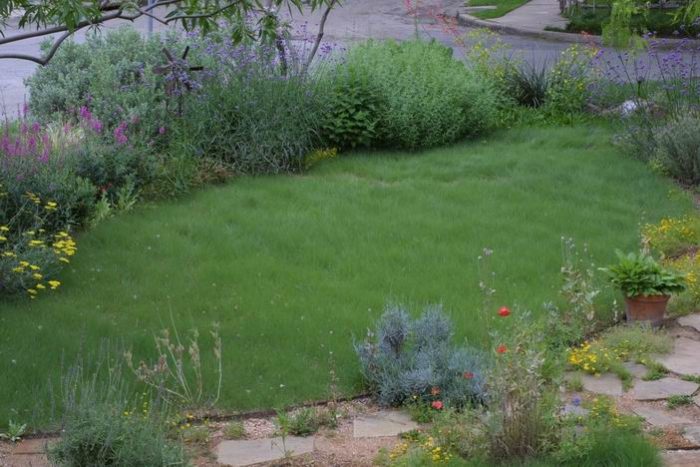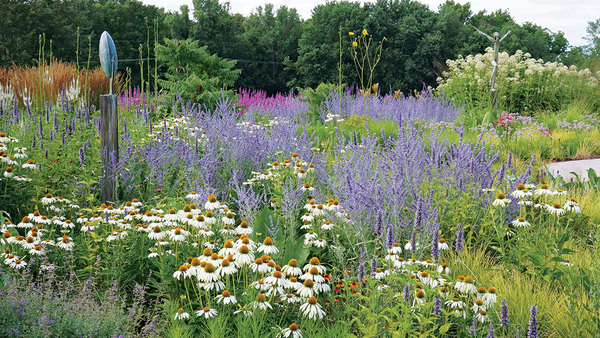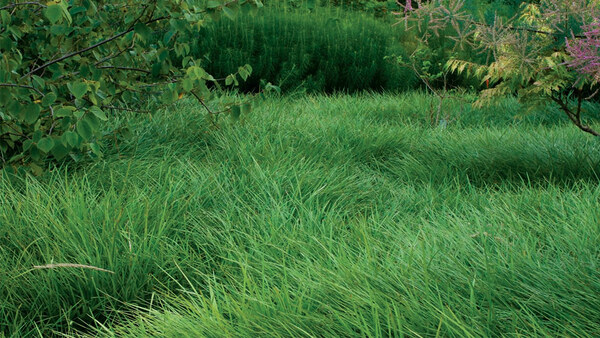
I was recently browsing through an Australian gardening magazine. (I read them so you don’t have to.) A column claiming that “turf is one of the most environmentally friendly products in the world” caught my attention. Here are some of its claims:
- Turf is drought-tolerant. Well, warm-season turf is.
- Turf can reduce carbon pollution. “Turf is much better than trees and shrubs at taking carbon from the air and locking it up in the soil.”
- Turf is the best natural chemical filter.
- Turf reduces heat.
I don’t know whether this is true or not, but it makes me think that the usual problems associated with turf (too much water, pesticides, fungicides) might be more the fault of the person with the lawn. If the lawn owner didn’t need a perfectly green carpet of grass, there wouldn’t be much need for all the fuss.
Much of my one-acre property is lawn grass. Actually, it is a mixture of lawn grass, weeds, clover, and anything else that happens to be growing there. I don’t lift a finger to maintain it (except mowing—which produces harmful emissions). I like my lawn and have no reason to remove it: What would my kids play on? But I also don’t water it or feed it.
Could it be that lawns aren’t the problem, but improper expectations are?

















Comments
Steve: I whole-heartedly agree that blades of grass (or alternatives like sedge) aren't directly to blame. In terms of sustainable lawn care, if the plant can survive with minimal input of resources (water, fertilizer, fossil fuels) and doesn't produce harmful by-products like air pollution, toxic run-off or pesticide drift, have at it.
However, most people and lawn care services are not able to pull this off. And a lot of people won't accept anything other than a lawn that looks like the picture on a bag of Scott's products.
If a lawn provides an actual functional space for recreation (like your case), then people should certainly have lawns. But they also need to assess whether that lawn (or any other garden feature) is having a negative impact.
There's no such thing as a zero impact garden unless we just walk away and let Darwin have his way. Most people wouldn't do that. My hope is that people at least become aware of the effect of their actions and consciously assess the trade-offs.
Thanks for starting the conversation.
Your fellow blogger (here at Cool Green Gardens): Billy Goodnick
I think most people who need the lawn that looks like a putting green are doing it for their neighbors. Until we all agree to forgive each other for imperfect front lawns, we will be stuck with these expectations for our lawns.
If it is green and doesn't hurt my feet, I consider it lawn. By the way, my lawn is in bloom right now: zillions of little clover flowers. It is beautiful, and you can't get that look no matter how many bags of Scott's 8-Step Perfect Lawn Product you put down.
I just planted some drought resistant Sheep Fescue on my side yard that gets a lot of sun. So far so good, due to my track record a good sturdy grass was what I needed. I was told it only needs to be watered once a month or so, I'm still a little skeptical of that.
I have read that grass is good for the environment, but i also like to see a little green in the yard. So I have a horseshoe shape graden bed with grass. Then a smaller bed with just flowers in the front on the house. The backyard we put in a patio to set and added grass around then added a flower bed. I have a need to see green in the yard.I like to fell it under my feet.
We have a lawn similar to yours Steve. I love to explore the many different plants growing in the lawn and the clover is gorgeous when it blooms. We also don't mow very often - mostly because I don't have the time (and I don't have the money for a service.) Last summer, I mowed 3 x - the surprising thing was that the lawn really didn't get that high - maybe 6 inches at most. Because of all the rain, it looks like I'll have to mow 5 times this year...
Log in or create an account to post a comment.
Sign up Log in